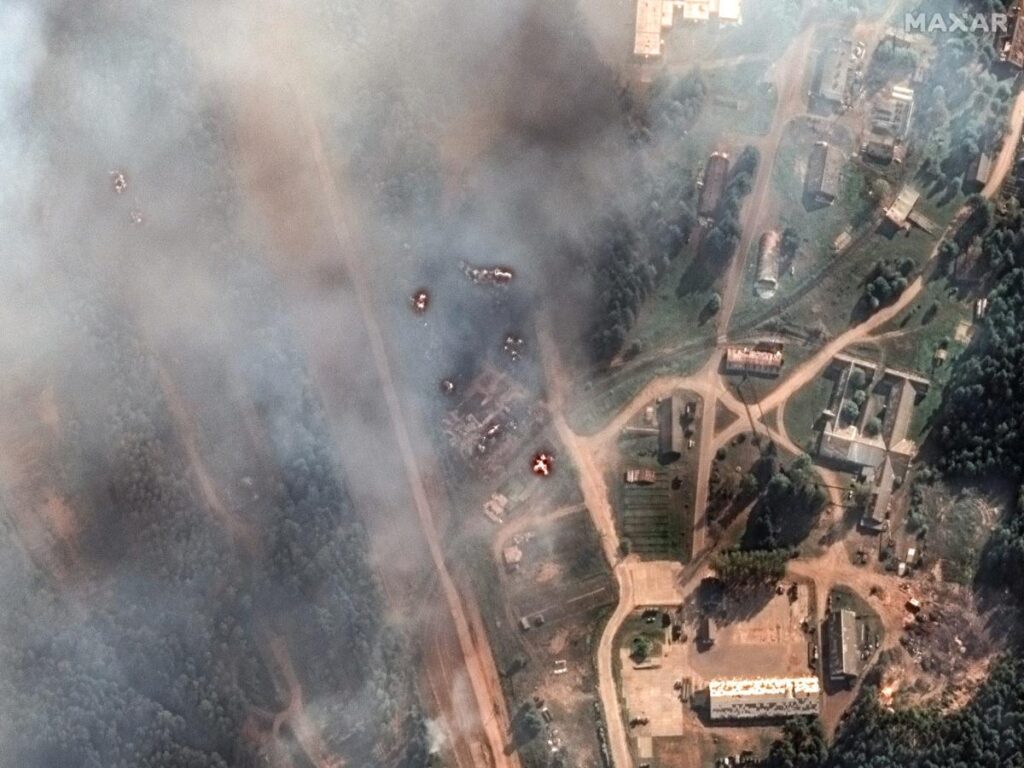-
Ukraine this week attacked a Russian arsenal with long-range attack drones.
-
The extent of the damage is unclear, but analysts believe similar attacks could put Russia in trouble.
-
A campaign against ammunition depots in Russia could force Russia to diversify its logistics.
Ukrainian long-range drones attacked a munitions depot in Russia this week, unleashing fireballs as bombs and rockets exploded. The latest attack targeted Moscow’s key military facilities deep inside the country’s borders.
Images showed widespread damage and fires at the site, but the long-term consequences of Tuesday’s attack are unclear. Analysts have suggested that the incident — and future ones like it — could put Russia in a serious logistical bind by forcing it to disperse more munitions and store them farther away from Russia’s war on Ukraine.
A source at Ukraine’s Security Service told Business Insider on Wednesday that the drones focused on a large warehouse in the town of Toropets, in Russia’s western Tver region, about 300 miles from the Ukrainian border. The source spoke on condition of anonymity to discuss sensitive operations.
The source said the warehouse, where ballistic missiles and artillery ammunition were stored, was destroyed in the attack, making it impossible for Russia to carry out deadly strikes on Ukrainian cities.
Video footage taken that night shows huge fireballs erupting from the facility and the next day satellite imagery captured plumes of smoke blanketing the area.
A former Ukrainian soldier wrote on social media that the scale of the attack was so great that Russia would not be able to quickly replace the lost ammunition.
Conflict analysts at the Institute for the Study of War think tank said that future Ukrainian strikes on weapons facilities deep inside Russia, like the attack in Toropets, would put pressure on Moscow that goes far beyond the immediate impact of a single strike. Moscow’s strategy relies on repeated, large-scale missile and bomb attacks.
For example, previous strike campaigns against Russian ammunition depots on occupied Ukrainian territory forced Russia to disperse weapons to less vulnerable locations. This complicated Moscow’s logistics at the time.
“Repeated attacks on ammunition depots inside Russia that cause a similar level of damage as the attack in Toropets could force the Russian military command to make a similar decision moment to reorganize and disperse support and logistics systems inside Russia to mitigate the impact of such attacks,” the ISW analysts wrote in a research published on Wednesday evening.
The SBU source said that Ukraine is indeed planning similar attacks to the one at Toropets on other Russian military facilities, such as those where weapons are produced or stationed en route to Ukraine.
Ukraine is prohibited from using its arsenal of powerful, Western-supplied long-range missiles to attack targets within RussiaTo circumvent these restrictions, Kiev has relied heavily on domestically produced attack drones in a campaign against Moscow’s military and energy facilities.
Ukrainian officials have long known that Western restrictions hamper their ability to effectively fight Russia. Yet Kiev’s persistent attempts to lift all restrictions have been unsuccessful.
“Russian forces may not have addressed vulnerabilities at many logistics facilities in Russia due to the safe space created by restrictions on Ukraine’s use of Western-supplied weapons. However, the Toropets facility is not within range of Western systems fired from Ukraine,” the ISW analysts said.
“Lifting restrictions on the use of Western systems and the continued development of Ukraine’s own long-range strike capabilities could enable Ukrainian forces to more effectively exploit such Russian vulnerabilities,” the analysts said.
Read the original article at Company Insider

